Discovering a small suitcase of family photographs while caring for her ailing mother back home in the Dolomites region of northern Italy, Margaret Innerhofer’s world was turned upside down. As she flipped through images of her mother’s youth, emerging from the shadows of fascism and World War II—photographs she had never seen before—she recalled stories from her childhood about family members from previous generations who fought against Mussolini's Fascist government and served in the underground movement during the battle against Hitler and the Nazis, all while striving to preserve their Tyrolean traditions. The parallels between those past events and the currents she perceives unfolding not only in the United States, but across the world felt unsettlingly vivid—a stark reminder of history’s cyclical nature and its relentless tendency to repeat itself.
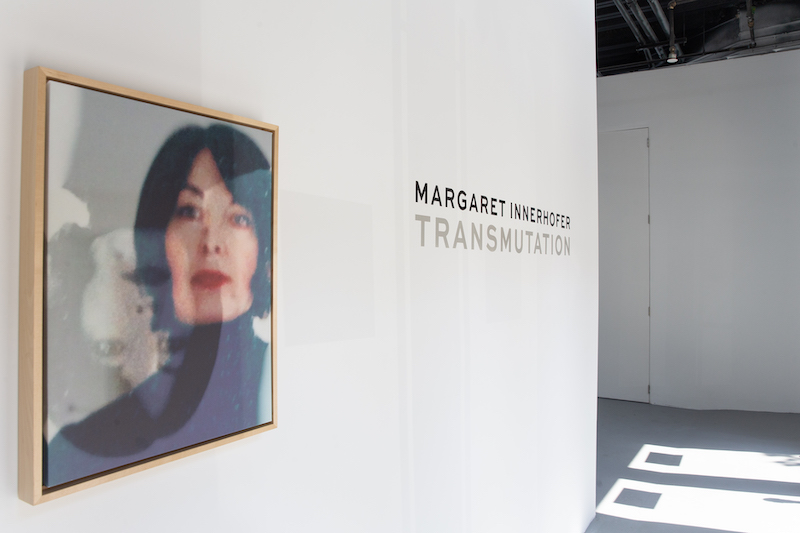 Margaret Innerhofer, TRANSMUTATION-MARGARETH, 2024. Photo: Zach Gross.
Margaret Innerhofer, TRANSMUTATION-MARGARETH, 2024. Photo: Zach Gross.
Preparing for her second solo show at Ethan Cohen Gallery—this time in their new Chelsea space, following her previous one-person exhibition last summer at the gallery’s Beacon location—the New York and Rhinebeck-based artist described the exhibition as “my birthing of ancestral unconscious, emerging through a process that entirely bypassed the rational mind, operating instead within the liminal space of instinct and inherited memory.” Through this process, she decided to tap into the psychic energy these photographic memories had stirred and chart her own life story.
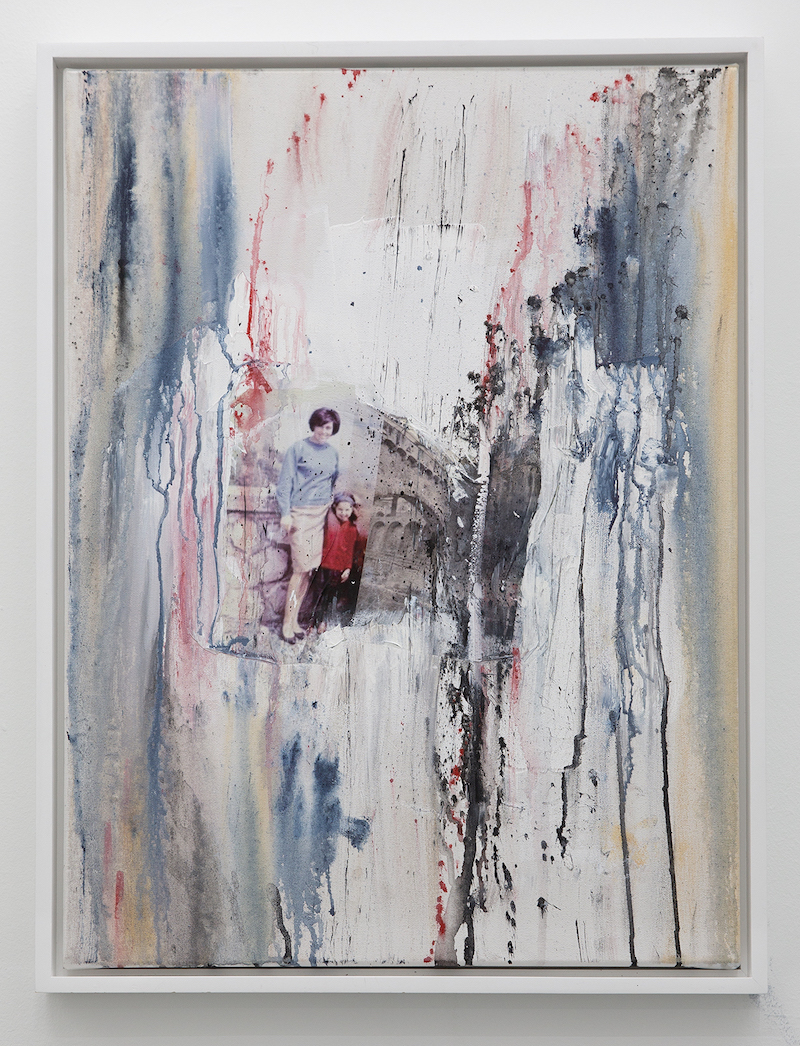 Margaret Innerhofer, TRANSMUTATION-MUTTER I, 2025. Photo: Zach Gross.
Margaret Innerhofer, TRANSMUTATION-MUTTER I, 2025. Photo: Zach Gross.
Asking her niece in Bolzano to scan the pictures in the valise, Innerhofer began working with the recovered images, constructing a visual narrative that traced her lineage—spanning ancestry, formative years as a student, personal relationships, and her professional life, where architecture, artistic practice, and activism coalesced, continually feeding and reshaping one another.
To envision the exhibition, she built a large-scale model of the newly redesigned Manhattan gallery, mapping out the choreography of the works in space. Pressed for time, she also turned to an elemental and urgent process—painting directly onto canvases nailed to trees for support, transforming her upstate garden into a primal open-air studio where nature itself became both witness and collaborator. Some of these paintings were later selected by the gallery’s curatorial team to be hung as autonomous works, while others were re-photographed and layered into her large-scale compositions, blurring the boundaries between mediums and expanding the dialogue between memory, materiality, and transformation that lies at the core of Transmutation.
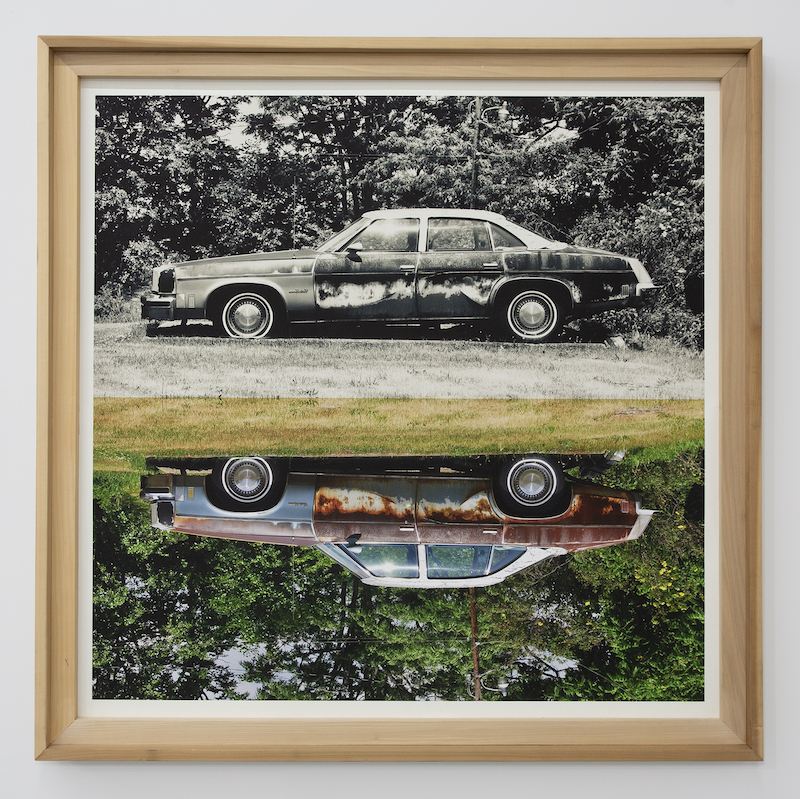
Margaret Innerhofer, Heavy Metal - Oldsmobile, 2023. Photo: Zach Gross.
The “Transmutation” exhibition, a Gesamtkunstwerk—or complete work of art—on view at the gallery from September 4 to October 4, 2025, features over 25 artworks created between 2023 and 2025, as well as a new sound piece. Exploring Innerhofer’s psyche through cycles of collapse and reconstitution, the exhibition deepens her investigation of Jungian archetypes, alchemical symbolism, and the interconnected realms of the personal, ancestral, and collective unconscious.
It begins with a recreation of the artist’s studio at the Kube Art Center in Beacon, NY. Showing large-scale photos from her acclaimed Heavy Metal and Deconstr-Activist series, which depict abandoned and outdated vehicles in places overtaken by time and nature, as well as architectural structures in a state of decay or collapse, the images present a dual perspective: one half in color and its mirrored image in black and white, with the black-and-white image facing upward, symbolizing the subconscious exerting its quiet but pervasive control—a concept rooted in Carl Jung’s principles.
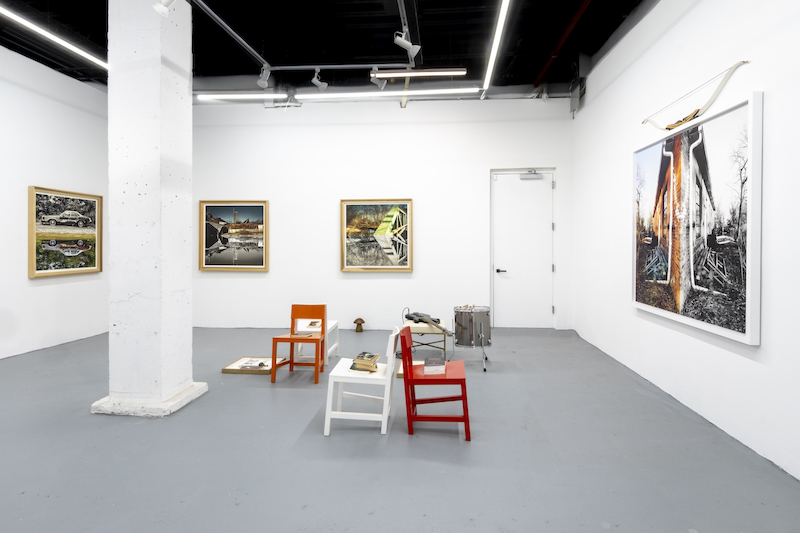
Installation view, Margaret Innerhofer: Transmutation at Ethan Cohen Gallery, New York. Photo: Weston Lee Andrews.
At the center of this first gallery, she arranged two sets of back-to-back red and white chairs, with perceptively selected books that represent paradigm shifts in her thinking and creativity, alongside a drum and an electric bass guitar, which she used to create a soundtrack for the exhibition, and two assemblages featuring books, painted photos, and Buddhist and Christian icons. Three additional mixed-media photographs, featuring expressively painted areas and attached objects that deepen their meaning—one of a horse, another of the renowned Fascist Hippodrome racetrack in her hometown, and the third based on a portrait of the young artist with her mother—act as a threshold, setting the stage for the journey to come in the expansive gallery below.
Descending the staircase, visitors enter a soaring two-story, cathedral-like space—a womb-like environment that immerses them in the unfolding narrative of the artist’s life, at least up to this point. The installation expands as a linear yet layered visual web, spanning designated and titled wall and floor segments—a psychic map tracing time, geography, and the artist’s shifting emotional states. Moving counterclockwise, the journey progresses metaphorically from the past toward the present.
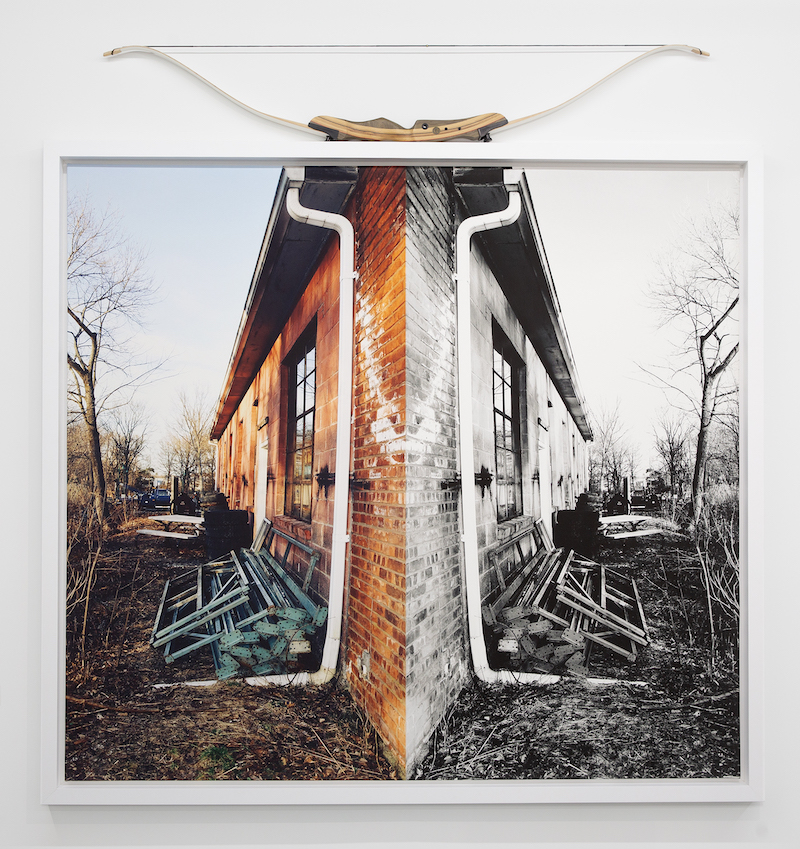
Margaret Innerhofer, DECONSTR-ACTIVIST I, 2023. Photo: Zach Gross.
A series of three images, from the segment of the show titled MUTTER, combines vintage black-and-white family photos of her mother with her brothers, uncle, and parents taking their wedding vows, interwoven with Innerhofer’s own landscape, architectural, and watercolor-painted photographs. These narrative collages are highlighted or obscured by black and red geometric bands that echo the geometry of the gallery columns and the nearby tree sculpture. The bands unconsciously draw on Innerhofer’s memories of an early job with the famed Italian graphic designer Massimo Vignelli, integrating principles of structure and spatial rhythm into the work. These black and red bands operate as visual metaphors for polarity—power and surrender, control and intimacy—illuminating the push and pull of opposing forces embedded within both personal histories and collective memory.
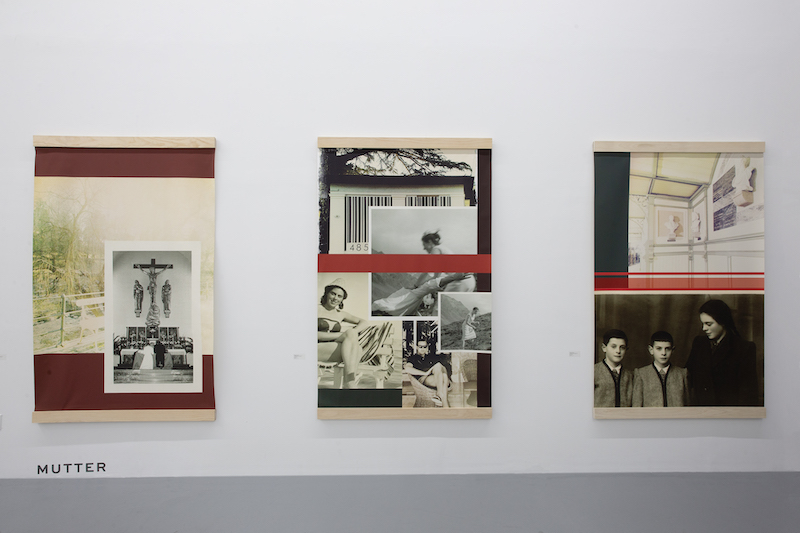
Margaret Innerhofer, MUTTER I-III, 2025. Photo: Zach Gross.
Next to the MUTTER section is PATRIAE, a three-part sector that includes a photomontage, a wooden sculpture, and a large-scale mural. In the PATRIAE artwork, a family photo of three women in traditional Tyrolean dress is contrasted with the artist’s photograph of the Victory Monument erected by Mussolini in Bolzano, which was annexed from Austria after World War I. PATRIAE, which translates from Latin to English as fatherland, tells the story of her great uncle, who was martyred after taking a bullet for a group of young locals resisting Italianization and the fascist takeover of their Tyrolean region and the erasure of their culture, while expressing the artist’s deep connection to a homeland that has been fought over for centuries.
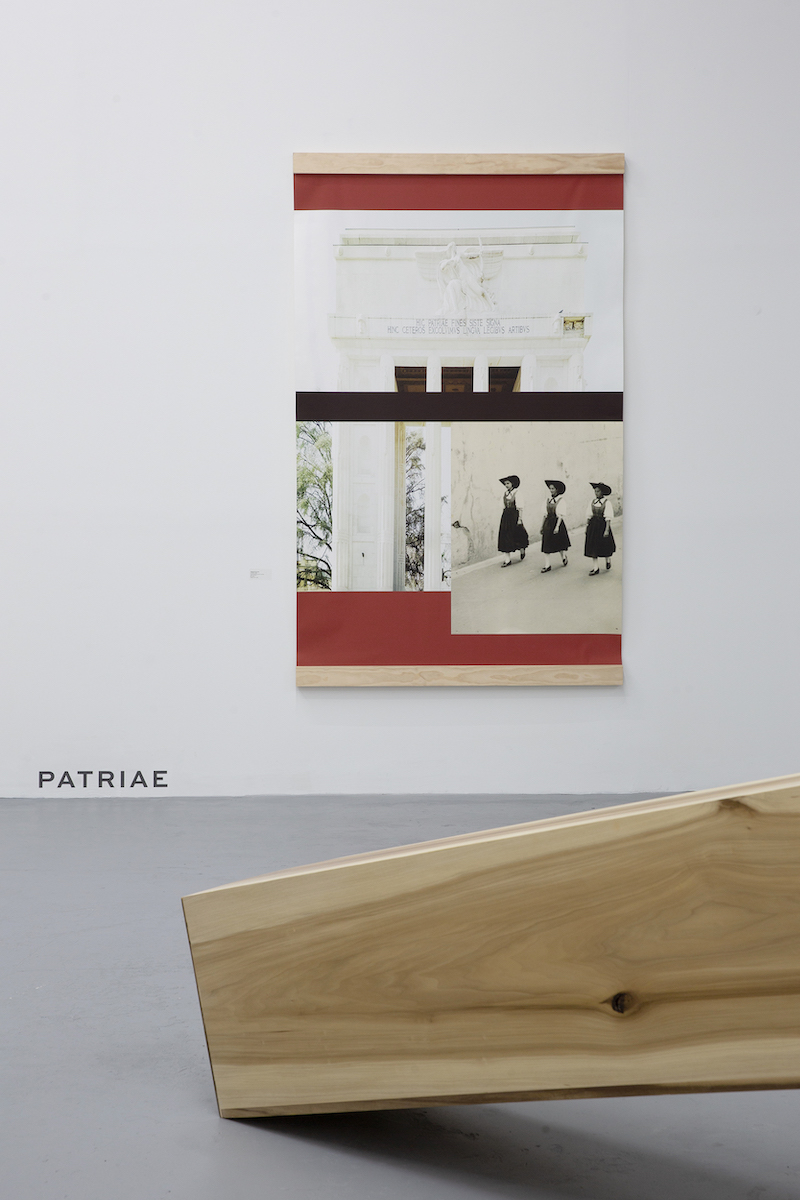
Margaret Innerhofer, PATRIAE, 2025. Photo: Zach Gross.
Highlighting the theme of homeland, Innerhofer created ROSENGARTEN-l, a large, split mural on the floor and wall as part of the PATRIAE segment. This installation features an appropriated vintage color photograph and its mirrored black-and-white image of the Dolomites. (A UNESCO World Heritage Site). The Rosengarten (Rose Garden) massif derives its name from a striking natural phenomenon locally known as “Enrosadira,” in which the dolomite rock faces glow a vivid rosy red at sunset. The Dolomite region has long been a contested landscape—a place where borders and empires have shifted over millennia. Its terrain carries the weight of ancestral memory, myth, and histories of resistance. This layered geography reflects cycles of conflict and reclamation, mirroring the psychic landscapes explored throughout “Transmutation.”
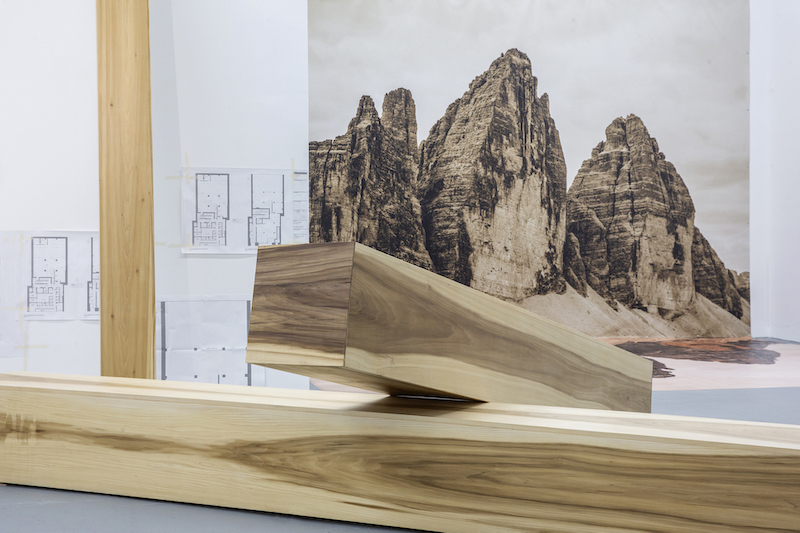
Installation view, Margaret Innerhofer: Transmutation at Ethan Cohen Gallery, New York. Photo: Weston Lee Andrews.
Completing the trilogy, three wooden sculptural logs called Trees tumble outward from the mural, echoing the structural supports of the surrounding architecture. Two of the tree-like forms have fallen, while the third remains standing, leaning against the gallery wall and architectural drawings. This composition symbolizes the artist's environmental activism and the cycle of destruction and renewal—tracing a passage from the cut tree to its transformation into a new structural element, a rebirth through architecture.
In the RUDOLF sector, architectural floor plans of the gallery space are paired with a large-scale photo composition of Innerhofer and Stingel, based on a portrait of the couple that Stingel recently used for a massive self-portrait painting in a solo show at Gagosian, where he cut his mate out of the original image. Innerhofer reinserted herself into her composition, layering her image back over Stingel’s self-portrait to reclaim and transform the narrative. Another torn-up image of herself, discovered in the valise, symbolizes the dissolution of their 10-year relationship in Milan, which incidentally brought them both to America.
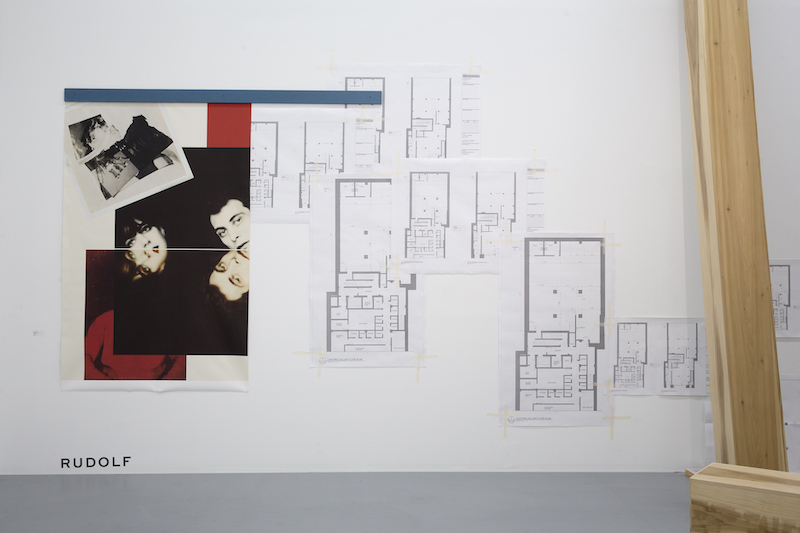
Margaret Innerhofer, RUDOLF-I, 2025. Photo: Zach Gross.
The RUPTURE part of the show offers a series of images that trace a period in Innerhofer’s life in New York City. Fractured figures—limbs, faces, and forms pulled apart and reassembled—mirror the psychic dislocation of a relationship’s collapse, evoking sensuality, memory, and the layered textures of urban life.
The exhibition concludes in the ETHER zone, a peaceful reflection on nature, impermanence, and the unseen—a Buddhist-inspired visual koan that encourages contemplation of the subtler realms of existence. In these ETHER montages, Innerhofer layers photographs from her archives, blurring time and memory much like the dissolving states experienced in meditation. The overlapping images are rendered slightly blurred and out of focus, erasing any fixed sense of time and creating scenes that feel both present and distant, ephemeral and eternal.
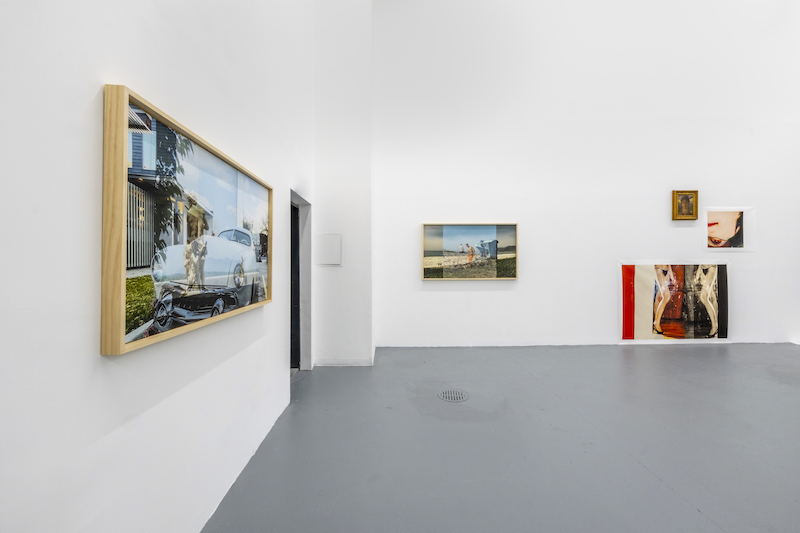
Installation view, Margaret Innerhofer: Transmutation at Ethan Cohen Gallery, New York. Photo: Weston Lee Andrews.
The series begins with an architectural lifeguard stand on a beach; a photo taken during a period when she spent extensive time photographing coastal scenes while married to a California surfer-turned-architect. Another image captures statues at the Vanderbilt’s Biltmore Mansion in North Carolina, evoking memories of her homeland, contrasted with a photograph of a vintage American car outside a modernist house in Austin, Texas.
The final work in the series, and the closing gesture of the exhibition, features a large white peacock—photographed at Lake Maggiore in Stresa, Italy, where the Medici family’s Pope would retreat to the Palazzo Borromeo, surrounded by their Renaissance art collection, with its splendid gardens and free-roaming white peacocks. This culminating image layers a red painterly gesture over the white peacock, evoking both violence and renewal, symbolizing Innerhofer’s spiritual freedom through meditation and artistic practice, and the tenuous hope that peace might one day prevail.
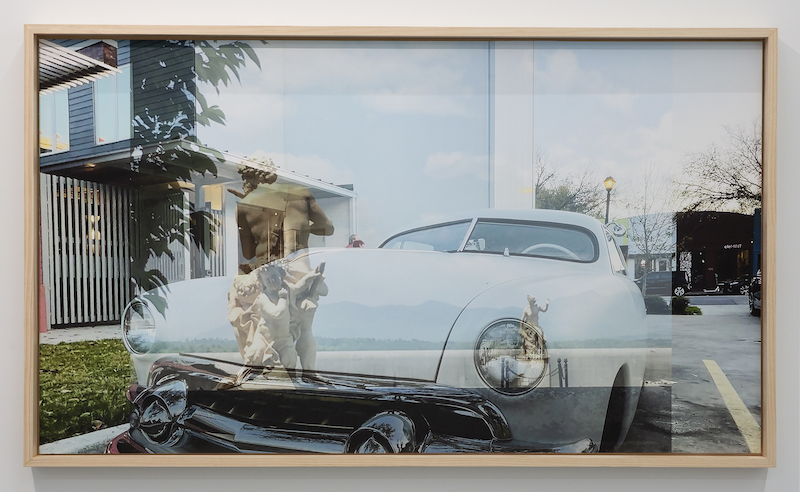
Margaret Innerhofer, ETHER-II, 2025. Photo: Zach Gross.
A droning soundscape permeates the exhibition like connective tissue. Conceived as if channeled from the large mountain mural itself, with the artist serving as the vessel through which its voice could emerge, the sound piece sustains an immersive drone in A minor, built from recorded wind textures and subtle bass phrases. Hovering between music and atmosphere, it never fully resolves into melody. This sonic environment envelops the viewer, serving as an aural counterpart to the visual and sculptural works, thereby deepening the emotional resonance of the exhibition.


